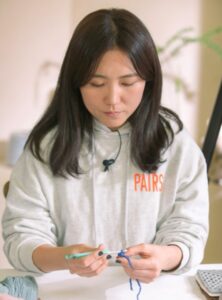In this issue of Flyway Story, we invited Ms. Inyoung Kim, textile artist from the Republic of Korea, to share with us how her artwork links with the conservation of migratory waterbirds, especially Spoon-billed Sandpiper.
“I’m grateful that I can be a part of the starting point to communicate about wildlife conservation with others.” – Ms. Inyoung Kim

Ms. Kim is designing her work ©Inyoung Kim / wonderwall
EAAFP: What are you currently working on?
Currently, I am preparing for the fourth book with like-minded people about knitting and crochet. I am also working on an overseas magazine, which is still ongoing. It is a project to let my readers follow my design instructions to make their own artwork. Another work is about Spoon-billed Sandpiper that I want to continue, so I am still working on it. I also have a plan to hold a private exhibition, but there are not many things to explain in particular since this is at the beginning phase.
EAAFP: What do you want to achieve through your artwork?
Well, it is quite a difficult question. Actually, I am immersed in craft art because I like the process itself more than any other purpose. I am still learning about the field. However, I believe that as I continue to do various craftworks, I can understand myself more and comfort others through my artwork, which enables communication with others.

Ms. Kim is working on knitting ©Inyoung Kim / wonderwall
EAAFP: Why did you choose textile art as a method to raise awareness of endangered species?
The biggest reason is that textile art is my best means of communication, but at the same time, I see fiber is close to our daily lives in the context of ‘protection’. I thought that the works made of these fibers would lead to warm and emotional consent for species that need protection. Also, due to the characteristic of textile art, it takes a lot of time to work. Therefore, in an era where everything is fast and instant, I thought that it could be a good means to let participants spend some time to think carefully about a topic for a while.
EAAFP: One of your project patterns is Spoon-billed Sandpiper. Can you tell us why you chose this species among many other endangered birds?
First of all, from a personal point of view, the characteristic beak was beautiful. Also, during the investigation, I found it pity that the number of this small but strong migratory waterbird has plummeted for several reasons. I wanted to initiate a public conversation about the bird before we lose them without knowing them.
EAAFP: What are your future plans or ambition to raise awareness of the conservation of endangered animal species?
I would like to continue working on projects as much as possible in my own capacity. I'm grateful that can be a part of the starting point to communicate about wildlife conservation with others. Thank you.
- For more about Kim In Young’s Spoon-billed sandpiper knitting project
- Learn more about EAAFP’s work on Spoon-billed sandpiper





